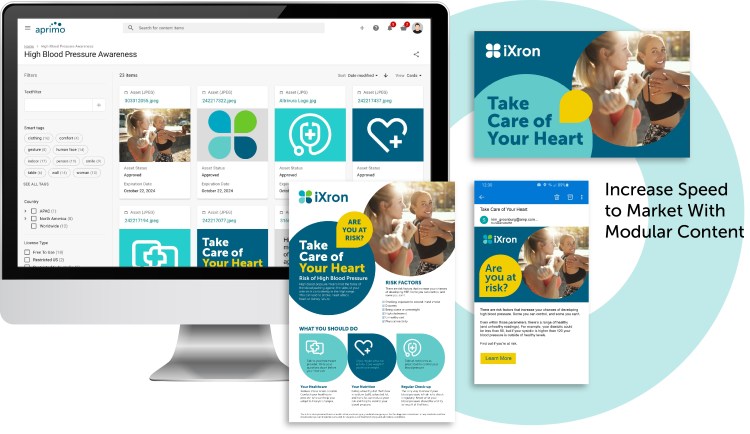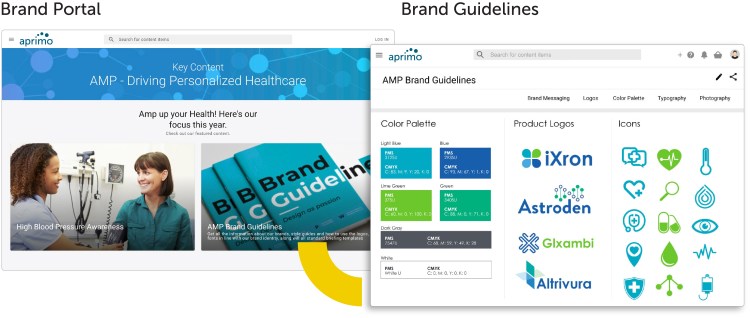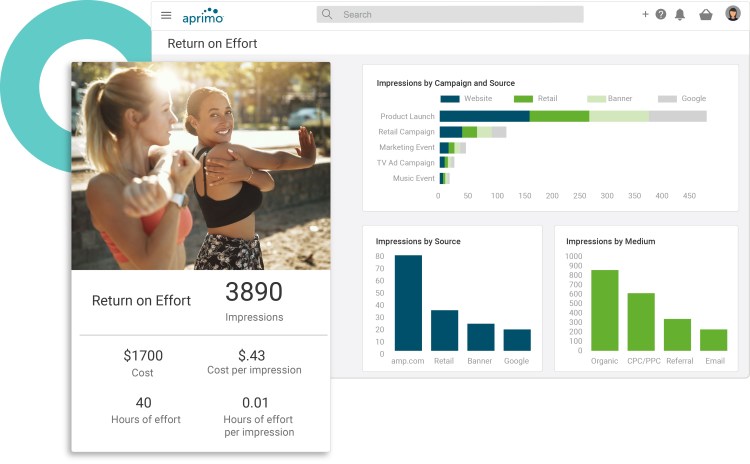Marketing organizations are under enormous pressure to continuously produce new content that drives impactful customer experiences. Yet, around 40% of the content at most organizations goes unused, according to a recent Aprimo survey.
So, where’s the disconnect?
The problem is rooted in inaccessibility and lack of insight into what content exists, where it exists, and if that content is up to date and aligned with corporate branding and legal standards. This makes it incredibly difficult to deliver the personalized, omni-channel experiences customers expect. In fact, of those surveyed by Aprimo, over 60% said they have room for growth when it comes to developing more personalized experiences at scale, and almost 20% say they have barely started with personalization.
To be fast to market with compelling customer experiences at scale, you need a more efficient and strategic way to manage your content so teams can access current, on-brand, and compliant content quickly and easily in any channel. When we asked those surveyed what the biggest obstacle was when it came to delivering personalized content, almost 65% answered resources and effort. That’s where modular content comes in.
Modular content is the key to re-use and optimizing marketing teams? time and resources so they can quickly and easily deliver great, on-brand and compliant customer experiences to market. Comprised of distinct blocks of content, teams can mix and match the blocks into different combinations to create new experiences.

Modular content will drive:
- More contextually relevant experiences
- Quicker reactions to market opportunities
- Faster creation of content and experiences
- Exponential content re-use, manageable content costs
- Lower regulatory and brand reputation risks
- Higher performing customer experiences
- Scalable customer experiences
- Consistent, high-quality brand experiences
The Key Use Cases for Using a Modular Content Strategy
There are four key scenarios in which using modular content delivers significant benefits.
- Personalization: Rather than creating content from scratch for each customer segment, marketers can break content down to blocks and then reassemble content according to smart or predetermined logic. Using this approach, you can scale content creation and utilize instant feedback to test, learn and quickly optimize personalized content experiences.
- Market expansion: Develop relevant, localized content for different markets with reusable content blocks and expand/grow new markets more quickly. Get regional and localized customer experiences to market faster by re-using content blocks rather than starting from scratch.
- Omnichannel: Channel siloes abound and creating content for every channel becomes time-consuming and burdensome. By re-using content blocks in new, channel-focused combinations, marketers can more quickly get omnichannel experiences to market while still creating the best, channel-specific experience.
- Compliance/Brand: Content is exploding, with many different groups involved in creating content. The risk that these groups create content that may be off-brand or incorrectly used is high. Modular content lessens the burden of regulatory and/or brand non-compliance by enabling the re-use of already-approved content and providing guidelines on how to re-use content.
Modular Content Supports a Tiered Content Approach
When we talk about modular content, there are three categories available to content creators:

Content Block: These are individual content items at their smallest, re-usable component. This could include a text snippet, disclaimer, a short-form video, or individual product shot.
Content Set: These are the combined assets that are often used together in distribution channels (e.g., product image + romance copy, disclaimer, and loan ad)
Content Experience: This is the final group of assets that are presented to the customer and includes the most relevant content set plus the presentation layer styling. This could be an email with template design, marketing copy, disclaimers, and a video. Content experiences can also be de-constructed to become content sets or blocks.
Tips for Preparing Your DAM for Modular Content
Preparing your content is one thing, making sure your DAM is ready for this change is another. Here are a few practical tips for how to prepare and strengthen your content and your DAM for your brand’s future needs.
- Centralize your content: Central control of modular content is critical. With a DAM you have granular control over which content is applicable for which markets, regions, brands, channels and so on.
- Avoid duplication: If you want the ability to track unique relationships between blocks, sets, and experiences, then you should avoid duplicate content?and you should be fanatic about it.
- Optimize metadata: For DAM librarians, managing metadata on existing content is already a challenge, so having more content objects with modular content will add to this stress. When it comes to modular content, you can use metadata inheritance, which enables a content object to automatically inherit some or all of its metadata from a parent asset, which it knows through a relationship. In addition to being more efficient, this process also ensures that if something changes within the original or parent asset, all localized versions will be updated as well.
- Connect the source files: To effectively measure performance, you need the ability to track all content instances and experiences from the source file. By doing so you can answer questions like: Where was the content used? How well did it perform? What return did it give us on all channels and all experiences?
Improving Content an Experiences Using Brand Management Tools

Now that you have modular content in your DAM, how can you get it out to the people that need to use it? And how do you communicate what it is how and how it should be used?
That’s where Aprimo’s brand management tools come into play. Using brand portals, different audiences can easily access the modular content they need along with brand guidelines. Configurable brand templates enable users to really tailor and personalize the experience as they go to market to optimizes outcomes for their specific audience.
Measuring the ROE of Your Modular Content

Aprimo provides a return on effort (ROE) dashboard that measures information about consumption of public links on your content, information on downloads, views, and more so you can truly understand if the effort spent creating that content was worth it.
With modular content, we will be able to take ROE to the next level by also tracking information about the block into the experience and the other way around. We will be able to add more statistics on what was leveraged through renditions, with stats from files and public links, from inside Aprimo and integrations. This means, you will be able to measure the success of not just your content, but the experiences created using that content.
To learn more about content reuse and modular content, watch the webinar ?Content Reuse: Modular Content Challenges and Management Tips.?


